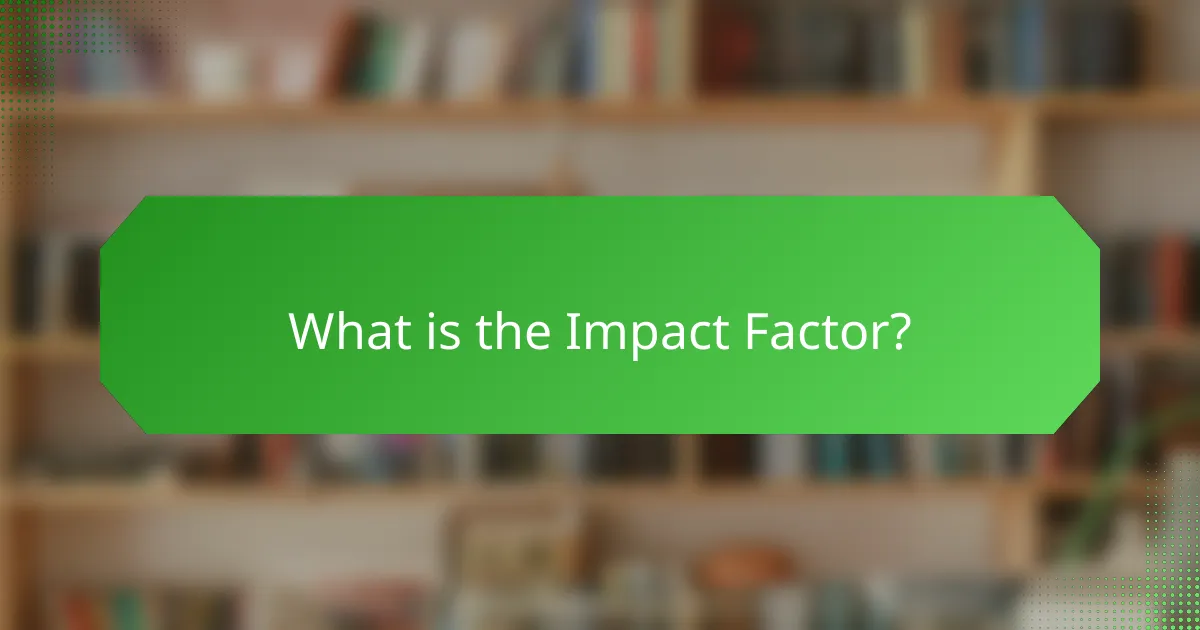The Impact Factor is a crucial metric used to assess the average number of citations received by articles published in a specific academic journal. It is calculated by dividing the total citations in a given year by the number of articles published in the two preceding years. This article explores the calculation of the Impact Factor, its significance in evaluating journal influence, and the limitations associated with its use in academic publishing and research assessment. Understanding these aspects is essential for researchers and academics who rely on this metric to gauge the quality and impact of scholarly work.

What is the Impact Factor?
The Impact Factor is a metric that measures the average number of citations to articles published in a specific journal. It is calculated by dividing the number of citations in a given year by the number of articles published in the previous two years. For example, if a journal has 100 citations in 2022 for articles published in 2020 and 2021, and it published 50 articles in those two years, its Impact Factor would be 2.0. This metric is often used to evaluate the relative importance of a journal within its field. Higher Impact Factors generally indicate more influential journals. The metric is widely used in academic publishing and research evaluation.
How is the Impact Factor calculated?
The Impact Factor is calculated by dividing the number of citations in a given year to articles published in the previous two years by the total number of articles published in those two years. For example, if a journal has 100 citations in 2023 for articles published in 2021 and 2022, and it published 50 articles during those years, the Impact Factor would be 2.0. This calculation provides a measure of the average number of citations per article. The formula is widely used to assess the relative importance of journals within their field.
What metrics are used in the calculation of the Impact Factor?
The Impact Factor is calculated using two main metrics. These metrics are the number of citations received by articles published in a journal and the total number of articles published in that journal during a specific time frame, typically two years. The formula for calculating the Impact Factor is the total number of citations in the current year to articles published in the previous two years divided by the total number of articles published in those two years. This metric provides a measure of the journal’s influence and prestige within its field.
How often is the Impact Factor updated?
The Impact Factor is updated annually. This update typically occurs in June. The update reflects citation data from the previous two years. For example, the 2023 Impact Factor is based on citations from 2021 and 2022. This annual update allows for a timely assessment of journal performance. It is published by Clarivate Analytics in the Journal Citation Reports.
Why is the Impact Factor significant in academic publishing?
The Impact Factor is significant in academic publishing because it measures the average number of citations to recent articles published in a journal. This metric helps assess the journal’s influence and prestige within its field. A higher Impact Factor often indicates a more impactful journal, attracting quality submissions from researchers. It influences funding decisions, tenure evaluations, and publication choices for authors. For example, journals with an Impact Factor above 10 are often considered top-tier in their disciplines. Thus, the Impact Factor serves as a key indicator of scholarly impact and journal quality in the academic community.
How does the Impact Factor influence journal reputation?
The Impact Factor significantly influences journal reputation by quantifying the frequency with which articles in a journal are cited. A higher Impact Factor indicates that articles are being referenced more frequently, suggesting greater influence and relevance in the field. Journals with elevated Impact Factors are often perceived as more prestigious. Researchers and institutions may prefer publishing in these journals to enhance their visibility and credibility. Additionally, funding bodies often consider journal Impact Factors when evaluating research proposals. This creates a cycle where high Impact Factor journals attract more submissions, further boosting their reputation. Studies show that journals with higher Impact Factors tend to have a larger readership and citation network.
What role does the Impact Factor play in research funding and career advancement?
The Impact Factor significantly influences research funding and career advancement. Higher Impact Factors often correlate with increased visibility and credibility in a researcher’s field. Funding agencies frequently consider publication in high-Impact Factor journals as a benchmark for evaluating grant applications. Researchers with publications in such journals may have better access to funding opportunities. Additionally, a strong publication record in high-Impact Factor journals can enhance a researcher’s reputation. This reputation can lead to promotions, tenure, and other career advancements. Studies show that researchers with high Impact Factor publications are more likely to receive citations, further validating their work. Overall, the Impact Factor serves as a key metric in the academic landscape, shaping funding decisions and career trajectories.
What are the limitations of the Impact Factor?
The limitations of the Impact Factor include its inability to account for the quality of citations. It primarily measures the number of citations received by articles in a journal. This can lead to discrepancies in evaluating the true impact of research. The Impact Factor also favors journals with a higher publication frequency. This may disadvantage journals that publish fewer but more substantial articles. Additionally, it does not consider the context of citations, such as whether they are positive or negative. The Impact Factor can be manipulated through self-citations, thus skewing results. Lastly, it overlooks the contributions of books and conference proceedings, which may also hold significant academic value.
How can the Impact Factor misrepresent the quality of research?
The Impact Factor can misrepresent the quality of research by emphasizing citation quantity over quality. It often reflects the average number of citations to articles published in a journal. This metric can favor journals that publish many review articles or highly cited papers. Consequently, it may overlook important but less frequently cited studies. Additionally, the Impact Factor does not account for the context of citations. A highly cited article may not necessarily indicate high-quality research. Furthermore, the Impact Factor can be influenced by self-citations or citation cartels. These practices can inflate a journal’s score without enhancing research quality. Overall, relying solely on the Impact Factor can lead to misconceptions about the true impact of research.
What are alternative metrics to consider alongside the Impact Factor?
Alternative metrics to consider alongside the Impact Factor include the h-index, Article Influence Score, and Scimago Journal Rank. The h-index measures both productivity and citation impact of a researcher or journal. The Article Influence Score evaluates the average influence of articles published in a journal. Scimago Journal Rank considers the number of citations received by a journal and its prestige. These metrics provide a broader understanding of research impact beyond just the Impact Factor. They account for different aspects of academic influence and citation practices.
How does the Impact Factor relate to other bibliometric indicators?
The Impact Factor is a key bibliometric indicator that measures the average number of citations to articles published in a journal. It is often compared to other bibliometric indicators like h-index, citation counts, and Altmetric scores. The h-index evaluates both the productivity and citation impact of a researcher. Citation counts provide a raw number of citations for individual articles or journals. Altmetric scores assess the online attention and engagement an article receives across various platforms.
While the Impact Factor focuses on journal-level citations, the h-index and citation counts can be applied to individual authors or specific articles. Unlike the Impact Factor, which is calculated annually, the h-index remains constant and only increases. Altmetric scores can reflect immediate public interest, while the Impact Factor reflects longer-term academic impact. Thus, while the Impact Factor is significant, it should be used alongside other metrics for a comprehensive evaluation of research impact.
What trends are emerging in the use of the Impact Factor?
Emerging trends in the use of the Impact Factor include increasing scrutiny and criticism. Researchers are questioning its effectiveness as a sole metric for assessing journal quality. There is a growing movement towards alternative metrics, such as article-level metrics and altmetrics. These alternatives provide a broader view of research impact beyond citations. Additionally, some institutions are shifting towards using a combination of metrics for evaluation. This trend reflects a desire for a more holistic approach to measuring research quality. Recent studies have shown that reliance on Impact Factor can lead to skewed publication practices. Journals are also diversifying their metrics to attract a wider range of submissions.
What best practices should researchers follow regarding the Impact Factor?
Researchers should critically assess the Impact Factor when selecting journals. They should prioritize journals that align with their field of study. It is essential to understand that the Impact Factor reflects citation frequency, not article quality. Researchers must also consider other metrics for a comprehensive evaluation. They should avoid solely relying on the Impact Factor for career advancement decisions. Engaging with a diverse range of journals can enhance visibility. Researchers should stay informed about the limitations of the Impact Factor. This includes recognizing its susceptibility to manipulation and the variation across disciplines.
The Impact Factor is a key metric that measures the average number of citations to articles published in academic journals, calculated by dividing the number of citations in a given year by the number of articles published in the previous two years. This article explores the calculation methods, significance, and limitations of the Impact Factor, highlighting its role in evaluating journal influence and prestige, as well as its impact on research funding and career advancement. Additionally, it addresses the criticisms of the Impact Factor and discusses alternative metrics that provide a broader understanding of research impact. Emerging trends and best practices for researchers regarding the use of the Impact Factor are also examined.


